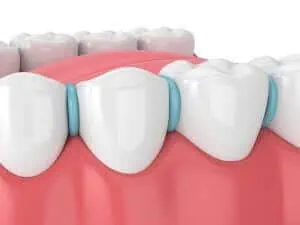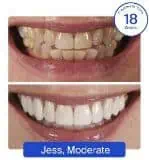Have you been told you or your child need spacers for braces? Most of us are familiar with what dental braces are, but not so many people know how orthodontic separators help braces function properly.
Understanding intricacies like teeth spacers can help you get a clear picture of the procedure involved with getting braces and make the whole process seem a little less daunting.
In this article, we’re going to fill you in on all there is to know about getting dental spacers before braces. We’ll offer the answers to questions like:
- What do spacers do for your teeth?
- Are spacers for braces painful?
- Can you eat with them?
- What happens if they fall out?
We hope this helps prepare you for the orthodontic work that you or your child are about to undergo.
If you’re concerned about having spacers for braces, you may also want to consider clear aligners as an alternative, as they won’t need spacers. Although they have a more limited range of tooth movement than braces, they can still treat a wide variety of orthodontic cases.
Our top pick is Smile White. These Aligners can treat 90% of cases. They’re almost ‘invisible’, much more affordable, and as a bonus, you’ll get free whitening and retainers worth £790.
Read our Smile White Review for more information or book a FREE e-consultation.
Use code DENTALY5OFF to get 5% off your treatment.
What are spacers for teeth? What do they do?

Spacers for braces are technically known as orthodontic separators or spacers, but they can also be called dental spacers or teeth separators.
In any case, they are simply rubber bands or orthodontic metal bands measuring about a centimetre in diameter. They are typically placed between the molars (back teeth), or between specific front or middle teeth, to create space before braces are fastened on. A patient may have one to eight spacers installed before braces are fitted.
Why do you need spacers before braces?
More often than not, a tooth spacer is used if the patient’s teeth are overcrowded. To secure it in place, the orthodontist stretches it and presses it firmly between the teeth with a word of caution that it must not be picked at or it may fall out.
Typically, dental spacers are secured between teeth a week or two before braces are put in. This time is enough for the molars to move sufficiently far apart. The small gaps that spacers create are required for brace appliances like molar bands or expanders to be fitted afterwards.
The short video below demonstrates the procedure for placing orthodontic separators (elastic in this case) and shows the gaps created between the teeth in just a few days.
Are orthodontic spacers painful?
Most people experience some pain or discomfort from spacers for teeth. After all, they’re putting pressure on the teeth and forcing them to move quite quickly. It mainly depends on how tightly spaced your teeth are to begin with:
- For people with relatively small or no space between their teeth, brace spacers can cause irritation in the nerves which may result in constant, but bearable pain.
- For some people, separators don’t hurt teeth when initially applied but start to ache after a while.
- Spacers can hurt more when eating, especially with hard or chewy foods.
- In a few rare cases, spacers can dig into the gums causing swelling and occasional bleeding.
Usually there’s nothing to worry about if any of the above happen. Orthodontists suggest that it is perfectly normal. Discomfort can be minimised by drinking cold drinks, eating yoghurt or ice cream, and taking over-the-counter painkillers as directed.
After having spacers installed, you may feel like there’s something stuck between your teeth, (because there is!) and you may be tempted to remove it. But trying to do so isn’t advised. Attempting to dislodge or adjust spacers might cause them to fall out. Although this may relieve discomfort in the short term, it will make the next step in the process tougher and more painful. Or, you’ll just need to have the spacers fitted all over again.
Keep in mind, this is no excuse to stop brushing your teeth! Brushing doesn’t lead to the displacement of dental spacers. In fact, regular brushing is encouraged while they are in place.
If you’re worried about getting spacers for braces, you may also want to consider other orthodontic options such as clear aligners. Although the range of teeth movement is more limited than with braces, they can still treat a wide range of orthodontic cases.

- Treats up to 90% of Cases
- Up to 40% cheaper than Invisalign
- Buy now, pay later in interest-free instalments
- Rated 4.9/5 on Trustpilot
- As seen on 5, BBC, 4, DailyExpress, TheMail
- Get 5% OFF with our discount code DENTALY5OFF and FREE Whitening and Retainers worth £790
How long do spacers for braces hurt?
The level of discomfort caused by teeth spacers differs for each patient. However, any initial soreness or pain from dental spacers being placed usually fades away after about four to six hours. You may experience some aching over the next couple of days while your teeth shift around. If this happens, take solace in the fact that it is normal, and the pain will dissipate.
Below you can see what getting teeth spacers before braces was like for this patient:
Can you eat with orthodontic separators in your teeth?
One of the most significant negatives of having spacers and braces is that you can eat only specific kinds of food once they’ve been put in place. Let’s take a look at foods you should stay away from.
Which foods should be avoided?

- Chewy, sticky foods like sweets and chewing gum can stick on and around the braces and spacers.
- Hard foods that need more strength while chewing, like nuts, corn on the cob, and raw hard fruits can lead to breaking of the wires in your braces. If you’re still on spacers, chewing hard foods can cause quite a bit of pain as well.
- If you eat something that’s exceptionally high in sugar and starch, it can cause plaque to accumulate around spacers and braces, increasing chances for decay.
This last reason is also why your orthodontist will advise you to continue a proper brushing routine once you get spacers or braces put in. It will not only help prevent staining and decay, but also make sure food particles don’t get stuck in your braces and the gaps between your teeth.
Your dentist may tell you to avoid flossing between the teeth with spacers, to avoid dislodging them. But once your braces are fitted it’s important to clean between your teeth every day.
If your braces or spacers are making it painful to eat, it’s best to stick to soft foods like pasta, yoghurts, mashed potatoes, smoothies and soup.
What should I do if my teeth spacers fall out?
If you’ve been following your orthodontist’s advice carefully, there are minimal chances of teeth separators falling out on their own. However, it might happen in rare circumstances. If it does, it may be because there is already enough room between your back teeth.
Can you put a spacer back in your own mouth? As the video above showed, dentists use special tools to place orthodontic spacers so it’s best not to try and do this yourself. If your teeth spacers fall out on their own, or due to your attempt to alleviate pain, call your orthodontist immediately. They might want to call you in to check whether the spacers should be replaced.
Spacers for baby teeth
Although they have the same name, the spacers that your child might get when they begin to lose their baby teeth are quite different to orthodontic spacers.
Also called space maintainers, spacers for baby teeth are used when a child’s baby tooth is lost prematurely, from being knocked out or from decay. These devices are used to stop the adjacent teeth from moving into the empty space and causing permanent teeth to come in crooked.
This is just one of the many reasons why it’s so important to start bringing your child to the dentist at a young age, as early as their first birthday, or within six months of the first tooth eruption. You can read more about caring for your baby’s teeth in our separate guide.
Losing baby teeth too early can put future smiles at jeopardy. This is why space maintainers serve such an important role. Space maintainers are dental devices for children that lose baby teeth before their adult teeth have erupted. Spacers help safeguard your child’s dental health as they grow. They also ensure that their future smile results as it should.
Not all space maintainers are the same. There are both removable and fixed devices. Removable devices are similar to an orthodontic retainer and can be removed for eating and cleaning. A fixed space maintainer is affixed to the teeth or gums around the vacated tooth space. They are often used for small children not quite old enough to care for a removable device. Choosing the right fit for your child’s needs is handled specifically by your dentist.
Dr. Catalina Botero, Li’l Sunshine Smiles Dentistry
Conclusion
To recap, spacers for braces create small gaps between teeth, usually molars, so that a molar band or other appliance can be placed as part of orthodontic treatment. Orthodontic separators are only in place for a week or two, but they can be quite painful, especially to begin with. It’s a good idea to stock up on painkillers and soft foods to get you through the first few days.
Getting braces can be inconvenient, but knowing that your teeth will look better afterwards makes it all worthwhile. Dental spacers form an essential initial step for many in completing the application of braces, and the more you know about them, the more you can anticipate what’s in store. We hope this article has helped you feel more prepared for your teeth straightening journey.
FAQs
What’s the difference between a molar band and spacers?

Molar bands and spacers may seem similar, but their function is quite different. A spacer for teeth is placed around the molars before you get your braces, to create more space for the braces to do their job. Then, when it’s time to get braces, your spacers come out and a molar band will be placed around each of your back molars, in order to anchor your braces.
What happens after spacers are removed?
You will only have your dental spacers for a week or two before it’s time to get them taken off by your orthodontist. They’ll typically be replaced with a molar band for braces. Molar bands act to anchor your braces in place.
Does everyone get spacers before braces?
No, not everybody needs to get teeth separators before braces. Everyone’s teeth are different. If your teeth, especially your molars, are very close together, you may need spacers. That’s because when you get your braces, molar bands may need to be placed around your back molars in order to anchor the braces in place. Rubber or metal brace spacers will help make room for those molar brands. Your orthodontist will be able to let you know if you need a spacer before braces.
People who get treatment with Invisalign or other invisible braces won’t need brace spacers either.
MAG Online Library: Separators: a review of uses and limitations. Consulted 6th July 2020.




